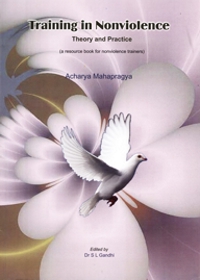Not only man but also every living being wants to live in peace and happiness, but the truth is that no one is content and happy today. There are two great obstacles in his desire:
- Adverse circumstances
- Violence
Circumstances do not affect man directly but they create a frenzied situation by impacting on his internal system.
Avesh (a frenzied state of mind) is the main cause of violence. There are many forms of avesh.
- Hunger
- Lack of the fulfilment of the basic needs of life
- Excessive indulgence in unrestrained consumption
- Racial frenzy
- Sectarian fanaticis
Of these forms of avesh, the strongest one, which causes excruciating pain, is hunger. It is the prime cause of violence. There is no difficulty in admitting the truth that if the problem of hunger is solved, violence will be reduced by 50% at a global level. Mahamatya Chanakaya’s statement that ‘there is no greater enemy than hunger’ (nasti kshudhesam shatru) needs our attention. The problem of hunger has become the backdrop of terrorism and extremism. The list of the woes that beset us today includes old age, disease - physical illness, mental illness and death. Though hunger has been excluded from this list, it is the greatest state of human suffering.
A man can bear to suffer the pangs of old age for twenty to thirty years. He can also endure the pangs of a disease for a prolonged period but the pain of hunger caused by the fire of stomach is most difficult to bear. It is difficult for a person to put up with it even for some days.
Homes for the old are built to mitigate the suffering of old age. There are a large number of hospitals for the treatment of diseases but there is neither a hospital nor an ashram (refuge) to eradicate the suffering caused by hunger. Those who have an abundance of things to eat cannot experience the pain of hunger, nor can they know about it or understand it. Only those who do not get even two square meals a day experience this agony.
On the basis of this situation we have no hesitation in admitting that a man afflicted with the pangs of hunger can resort to any crime and can participate in any violent activity.
In the course of our Ahimsa Yatra, we studied the problems of villages as well the problems of the people living there. The educated elite, rich persons and officials of the Government inhabit the cities, hence more attention is paid to their beautification than to the sanitary conditions and basic infrastructure of the villages. In addition there are problems of education, health and employment. It is also not correct to say that the Government is not doing anything in this direction. But it will also not be wrong to say that it is not being done to the extent it should be done.
We came to know that the expectations of the rural people are not being fulfilled. What fills our hearts with anguish is that in the absence of any means of livelihood many individuals and families are not able to get even two meals a day. Every new state government vows that it will not allow any one to die of hunger. It may be true that the number of those who die of hunger is not large but the number of those who suffer from the pangs of hunger is very large. We have experienced it directly. We cannot remove avesh (the impulsive impetuosity) caused by hunger and poverty through change of heart. The reason is that this pain is caused by the absence of food - which is a material need. Hunger can be removed only by fulfilling that need. We must build a social system, which limits both accumulation and consumption.
Strong impulsive states of mind like anger; greed, fear, sexual lust etc. are of an individual character. They can be overcome by a change of heart or by transformation of one’s consciousness. That is why training in the fair means of livelihood has also been included in Ahimsa Prashikshan (training in nonviolence) along with the transformation of emotions. The results of ahimsa prashikshan are:
- Improvement in human relations
- Development of sensitivity and compassion towards all living beings
- Combination of training in nonviolence and training in the means of livelihood
- To build an environment of peaceful co-existence is a resolve for a healthy society consisting of healthy individuals to be taken to reach our goal
 Acharya Mahaprajna
Acharya Mahaprajna

